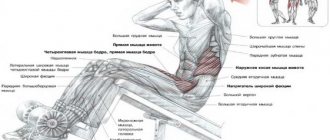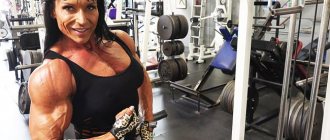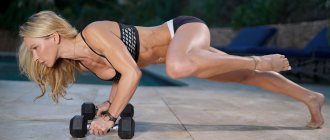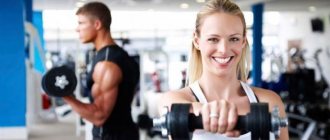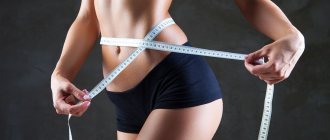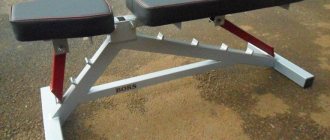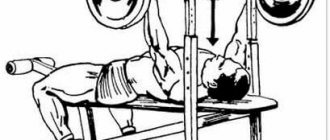Doing shrugs with a barbell is useful for everyone. Yes, even fitness ladies and office workers. Especially the latter, because movement improves cerebral circulation, makes you think faster and helps get rid of kyphotic posture. Yes, if you overdo it with shrugs, your neck will become visually shorter and thicker. But for a bodybuilder this is a plus. And for an extreme sports athlete, it is also an option for maintaining health, because if the neck is reliably protected by muscles, it will be more difficult to get injured. Shrugs with a barbell are a little more difficult to do than with dumbbells, but it's worth it.
Benefits of exercise
The trapezius muscle not only helps us raise and lower our shoulders, but also allows us to bring our shoulder blades closer to our spine and rotate our shoulders away from each other. It helps in lifting all types of weights from the floor, and stabilizes the shoulders when we do pull-ups or pull the barbell to the waist. Strong trapezius is a good “helper” in lift-ups, power cleans and other weightlifting movements.
Working out the trapezius with shrugs helps get rid of the feeling of stiffness in the shoulders and back that haunts those who are engaged in office work or drive a lot. This movement improves blood circulation throughout the upper body and nutrition of the brain. Sometimes simply adding shrugs to your workout plan will relieve headaches better than any manual therapy.
The applied sports aspects of the exercise are significant. Without working on the trapezius muscle, it is difficult to imagine a high-quality “assembly” of the back in squats and bench presses, as well as work in deadlifts. The trapezius muscles help the athlete efficiently perform all types of basic exercises that involve the back. Without working on the trapezius, it is difficult to imagine shoulder training in bodybuilding, because with an undeveloped trapezius, the figure will never be harmonious.
Important: Strong neck muscles are important in wrestling or extreme sports. Athletes of these types can incorporate shrugs into their general physical training to protect the cervical spine from injury and reduce the risk of spinal injury.
There are no complete contraindications, with the exception of two cases:
- Violation of the outflow of venous blood (pathology of venous valves);
- Severe scoliosis in the thoracic region
Domestic sources also add hernias in the lumbar region here, Americans are not so radical, they believe that hernias are not a hindrance, it is enough to qualitatively strengthen the rectus abdominis muscle and the muscles running along the spine.
For women there are two options. In strength sports you will just have to accept some increase in trapezius. All the same, it won’t be possible to pump up something really huge there, and the model’s puny shoulders won’t withstand the weight that girls usually squat. But for those who exercise simply for fitness, it makes sense to do exercises for the trapezius muscle not in failure mode, and perform about 20-25 repetitions to achieve fatigue, but not failure. This way the muscles will not grow significantly, and hypertrophy will not be achieved.
Injury prevention
Since the barbell is a serious weighting agent, exercises with it have an increased risk of injury. The main cause of accidents is poor exercise technique, so to avoid this, you must adhere to the following rules:
- Always start your workouts with a good warm-up, which should include cardio and warming up (stretching) all muscles. Accordingly, classes should be completed with a cool-down, during which the rapid pulse should gradually return to its normal state;
- there should be no pain or discomfort during the exercises. Our body is the best helper and adviser; we just need to learn to recognize the signals it gives us. A categorical desire to exercise, which arises by the time the next workout is due, is also a sure sign that something is being done wrong;
- strict implementation of the recommended technique also means that you need to avoid two possible extremes - feeling sorry for yourself, not working on it and pretending, and engaging in self-torture. Maximum muscle development, especially when working with a barbell, is possible only when the range of motion is no more and no less than recommended;
- increased speed during exercise is another enemy to our health. By performing all the required movements slowly, we train and tighten the muscles, and by jerking and accelerating, we risk getting sprains and other problems;
- by ignoring the laws of physics, in particular mechanics, we risk losing our balance and getting injured;
- You cannot start training with a barbell if you have certain diseases, primarily these include spinal injuries, problems with joints and the cardiovascular system. At a minimum, it is necessary to inform the coach about such circumstances, but it is better to first consult with your doctor;
- being distracted by extraneous conversations and even thoughts during training, a person loses vigilance and can cause harm to himself and others;
- sore throat (characteristic muscle pain after active physical activity) is a reason to temporarily reduce the intensity of training, and not force your muscles to work “to the breaking point”;
- increasing the load must occur gradually, otherwise injuries are inevitable;
- and, finally, lifting a barbell while intoxicated in your mind should once and for all be equated to a serious crime.
The barbell is an excellent helper for girls and women who want to make their butt toned and firm.
But in order to achieve success in using this equipment, you need to approach the problem with full responsibility, develop an optimal program for yourself in terms of load, and perform the entire range of exercises in strict accordance with the instructions of the trainer. Exercises Buttocks Sports and fitness Exercises for women Strength training Barbell exercises
What muscles work
Shrugs work the entire muscle mass of the upper body:
- Trapezius muscles;
- Diamond-shaped;
- Small thoracic and intercostal;
- Levator scapulae muscle
Specifically in shrugs with a barbell, the muscles of the legs, abs and core work as stabilizers.
The trapezius muscle consists of three segments
- The lower one presses the bottom of the shoulder blades to the back;
- Middle – shoulder blades to the spine;
- Upper – directly raises and lowers the shoulders
Barbell deadlift
This exercise is performed with both a barbell and dumbbells. This requires a good level of stretching, so it’s best to work on it in advance.
Deadlifts are optimal for girls, since performing this exercise puts the main load on the muscles of the buttocks, lower back and back of the thighs.
When performing deadlifts with dumbbells, try to hold them so that the dumbbell bars are parallel to your feet.
If you haven't done enough stretching and you can't deadlift properly, try doing the Romanian deadlift. When performing this exercise, the pelvis should also be pulled back, but the legs are slightly bent, and the bar of the bar is lowered to the middle part of the shins.
Types of shrugs with a barbell
Different types of exercise use different functional areas of the trapezius muscle. Each type of exercise brings certain benefits
Standing barbell shrugs
This movement is also called shrugs with a barbell in straight, lowered arms. For the most part, the movement works the trapezius muscles in their upper segment. This is a classic “trapezius exercise” to achieve hypertrophy. The movement consists of moving the barbell up and down along the vertical line of the body.
Shrugs with a barbell behind your back
Some athletes consider this movement aimed at developing the posterior deltoid muscles, but this is not entirely true. The delta works when bending the arms at the elbows; if the movement is limited only to raising the shoulders, then the target will be exclusively the trapezoid, and all its bundles, since when holding the projectile behind the back, the person will collect the shoulder blades towards the spine in any case.
Rich Piana | SHRUGS BEHIND YOUR BACK
Shrugs lying on a bench
This is to some extent a universal movement. It helps to work out all the bundles of the deltoid muscles, and allows you to adjust the level of load by tilting the back of the bench. Shrugs allow you to actively involve the rhomboid muscles in the work due to the fact that the shoulder blades must be kept adducted. This movement option allows you to qualitatively develop muscles and improve your posture.
Many athletes prefer to perform this exercise with a special block handle or dumbbells. The bar may not correspond to the anatomical features, its movement along the body may be difficult. Training with a barbell allows you to work on stabilization and teaches a person to perform elements of weightlifting exercises, but can negatively affect the health of the joint.
Pros and cons of training buttocks with a barbell
Like any physical training, barbell exercises have their advantages and disadvantages that you need to be aware of.
Advantages of barbell exercises for girls:
- due to the high load, they allow you to use a large number of different muscle groups, therefore, even if the main goal is to strengthen the buttocks, at the same time during the training process the whole body is toned and strengthened, the legs, back and abs experience especially heavy load;
- help not only to strengthen the gluteal muscles, but also to round, “lift” and clearly define them, as a result of which the hips become especially attractive;
- give an obvious effect that becomes noticeable quite quickly.
Did you know? The most expensive buttocks in the world belong to Jennifer Lopez.
In any case, this is what the American actress herself thinks, having insured her “loin” for $27 million. Kylie Minogue looks much more modest in this regard: the singer from Australia estimated her own butt at only five million “green”. Disadvantages of using a barbell for beautiful buttocks:
- exercises with a barbell are traditionally considered one of the most stressful types of training for the body; accordingly, they are suitable only for people who initially have good physical fitness (in particular, if the back muscles are insufficiently developed, using a heavy apparatus to work out the buttocks becomes impossible);
- the barbell is a very traumatic projectile, especially if it is in the hands of a non-professional (the lower back, as well as knee joints and ligaments, are especially often affected);
- classes require maximum precision in adherence to technique, so ideally they should be carried out under the constant supervision of an experienced trainer;
- specific equipment, can only be used in specially designed gyms; for home training, with rare exceptions, it is not suitable (the point is not only that few people have a barbell at home, but also that for such exercises you need a spacious and a soundproof room is desirable; in addition, many exercises, in addition to the barbell itself, require the presence of special simulators);
- exercises with a barbell are associated with a strong impact load, especially on the spine, which does more harm to the body than good (this disadvantage can only be mitigated by using a light weight of the projectile);
- can lead to a significant increase in the volume of the hips due to increased stress on the muscles, and this effect is not desirable for everyone (girls who want to squeeze into smaller jeans through training will be especially upset).
To achieve good physical shape and well-being, you should not ignore exercises for morning exercises.
Execution technique
- Spread your feet shoulder-width apart and grab the barbell with an overhand grip. The space between the palms is slightly wider than the shoulders.
- Fully straighten your back - straighten your shoulders and chest, bend slightly at the lower back, raise your head until it is parallel with the floor. In the initial position, the arms are straightened, the back is located in a vertical plane, the deflection of the spine is natural, S-shaped, and the gaze is directed strictly forward.
- Inhale and, stopping your breathing, tighten your trapezius, lift your shoulders up, towards your ears. Imagine simply shrugging your shoulders when someone asks you something and you don’t know what to answer.
- Do not bend your arms, tilt your torso, or squat. Your main task is to raise your shoulders in a vertical plane as high as possible, while keeping all other parts motionless.
- Raising your shoulders as high as possible, exhale and try to fix your shoulders in this position for a couple of seconds.
- Slowly lower your shoulders to the starting position.
Shrugs with a standing barbell: exercise for the trapezius muscles (execution technique)
Technique
The rod is installed on racks at an accessible height;
- First, the bar is grabbed with your hands, with a closed grip at a level slightly wider than your shoulders, then you “go” under the bar; the projectile is placed on the top of the trapezoid if the height is small and it is convenient; or the bar moves lower if the athlete is tall and her legs are long;
- use your palms to apply pressure to the bar so that it lies stable; Extension is performed in both knee joints, removal of the barbell from the racks, then stepping back and stopping;
- in a free position, the feet are spread to a comfortable width, if this is a classic squat - slightly wider than the pelvic bones, the toes are aligned with the knees, and not at any given angles;
- the stance should be stable; to stabilize it, the abdominal muscles contract, the stomach tightens, and the knees bend slightly before the first repetition begins; then there is flexion at the knee and hip joints, and lowering of the pelvis to the plane of the knee joint or lower;
- after that - lifting and a given number of repetitions; then you need to stop, take 2 steps forward and return the projectile to the racks.
Mistakes include placing the body on the hips, transferring the weight to the toes, bringing the knees inward and pushing with the knees.
The training process uses various modes, from 1-6 to 20 or more repetitions, depending on the goal. It is usually advised not to exceed the volume of more than 50 barbell lifts per workout.
Adviсe
- Throughout the entire set, keep your back straight and posture: shoulders back, chest straightened, back straight and slightly arched in the lower back. If you have trouble keeping your shoulders back, do dumbbell shrugs only.
- To achieve the maximum possible trapezius contraction, perform barbell shrugs so that your shoulders rise as high as possible.
- Always stop breathing while lifting your shoulders. This makes it much easier to stabilize the correct position of the spine and focus on contracting the trapezius.
- The purpose of the exercise is the upper part of the rhomboid and trapezius muscles, which respond well to loads and quickly grow, especially in width and upward, which is optically manifested in the form of a pumped-up neck and a clearly convex upper back against the background of pumped-up shoulders. Naturally, this emphasizes the strength of the figure, but only... for men. As for the female figure, overly developed trapezoids can completely deprive her of all attractiveness and femininity. Therefore, we strongly recommend that girls not get carried away with barbell shrugs (or even completely exclude them from their training list).
- The working weight should be feasible, allowing you to raise your shoulders as high as possible. An overly heavy barbell will fatally shorten the range of motion and, as your shoulders drop, force you to reflexively direct them forward, which risks rounding your spine and can lead to injury.
- During the entire exercise, the shoulders move only down and up. No rotational movements - this is dangerous, as heavy weight moves from the trapezius to the shoulder joints.
- Throughout the approach, look only in front of you. By lowering your chin, you risk bending your spine. By tilting your head to the side, you create all the conditions for the disproportionate development of the trapezius, which will ultimately lead to curvature of the cervical spine.
Deadlift, its types
The deadlift is considered a basic exercise; the result of its regular implementation will be muscle growth, increased strength and proper muscle development, because it is the deadlift that will load many muscle groups.
The classic method of execution will help to work the following muscles:
- back muscles. With the classic version, the maximum load is received by the spinal extensors, especially the lower back; in addition, the latissimus muscles are also well worked out.
- muscles of the legs and buttocks. Regular deadlifts work the quadriceps, thighs, and glutes.
In the classic version, the following are additionally studied:
- forearms, hands;
- trapezoid;
- abdominal muscles;
- calves and inner thighs.
Errors during execution
- Leaning body forward. As already mentioned, this leads to excessive stress on the lower back.
- Exit of the knee beyond the toe. Here the knee joints receive a lot of stress.
- Lifting your heels off the floor. If your stretching does not allow you to perform the exercise without lifting your heels off the floor, place something under them, such as a plate.
- Premature pelvic elevation . The rise should occur simultaneously with the straightening of the knees.
- Fast pace of execution. Exercises should be performed at a moderate pace, without making sudden jerks at any point in the amplitude.
- Position of the barbell on the neck. Place the bar strictly on the trapezoid.
For a visual example of how this exercise is performed, we have selected the following video.
Records among men
In 2020, Russian powerlifter Andrei Malanichev set a world record for barbell squats. His result was 485 kilograms without equipment! In 2010, he showed the best result in the squat without equipment - 450 kilograms.
Also a phenomenal athlete is Yuri Belkin, who is known not so much for the weight he was able to squat with, but for the ratio of his body weight to the weight of the barbell. In 2020, he managed to squat 440 kilograms with his own weight of 101.5 kilograms! The result is impressive.
However, the next three barbell squat records in a row belong to one person.
For the first time in March 2020, Israeli powerlifter Vlad Alkhazov set a world record of 505 kilograms. Thus, Vlad became the first person in the whole world who managed to squat with a weight of more than 500 kg without equipment.
A new world record for squatting with a barbell without equipment was set relatively recently at a powerlifting tournament in Minsk. The hero of the day was Vlad Alkhazov, who, with his own weight of 178.5 kilograms, managed to squat 510 kg on the barbell, thereby setting a new world record. However, Vlad did not stop there. And already in the second attempt he updated it, squatting with a weight of 525 kg.
All of Vlad's equipment consisted of only knee bandages, stretched to the limit.
It is worth noting that the new record holder is distinguished by incredible perseverance and the will to win, because in 2008 he received a severe knee injury with a tear of three ligaments and deformation of the joint. This happened while he was squatting with a heavier weight in sports equipment.
Vlad himself, after setting a new record, said that this result was achieved thanks to the three most dear women in his life - his mother, wife and daughter.
You can see how it happened in the video attached below.
